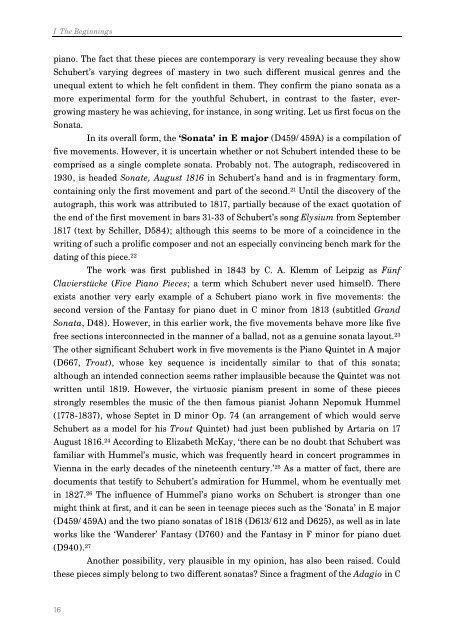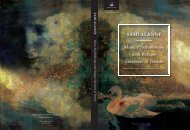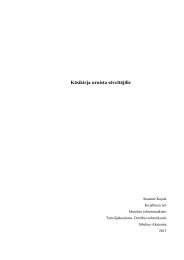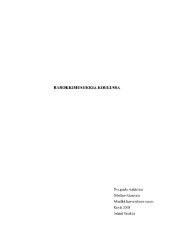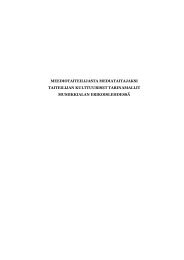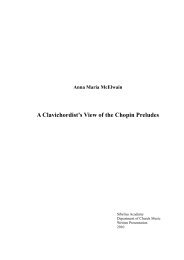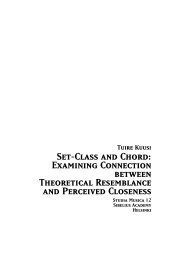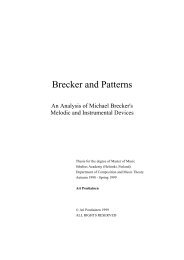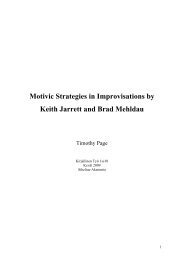The Unfinished Piano Sonatas of Franz Schubert Javier ... - Ethesis
The Unfinished Piano Sonatas of Franz Schubert Javier ... - Ethesis
The Unfinished Piano Sonatas of Franz Schubert Javier ... - Ethesis
You also want an ePaper? Increase the reach of your titles
YUMPU automatically turns print PDFs into web optimized ePapers that Google loves.
I <strong>The</strong> Beginnings<br />
piano. <strong>The</strong> fact that these pieces are contemporary is very revealing because they show<br />
<strong>Schubert</strong>’s varying degrees <strong>of</strong> mastery in two such different musical genres and the<br />
unequal extent to which he felt confident in them. <strong>The</strong>y confirm the piano sonata as a<br />
more experimental form for the youthful <strong>Schubert</strong>, in contrast to the faster, evergrowing<br />
mastery he was achieving, for instance, in song writing. Let us first focus on the<br />
Sonata.<br />
In its overall form, the ‘Sonata’ in E major (D459/459A) is a compilation <strong>of</strong><br />
five movements. However, it is uncertain whether or not <strong>Schubert</strong> intended these to be<br />
comprised as a single complete sonata. Probably not. <strong>The</strong> autograph, rediscovered in<br />
1930, is headed Sonate, August 1816 in <strong>Schubert</strong>’s hand and is in fragmentary form,<br />
containing only the first movement and part <strong>of</strong> the second. 21 Until the discovery <strong>of</strong> the<br />
autograph, this work was attributed to 1817, partially because <strong>of</strong> the exact quotation <strong>of</strong><br />
the end <strong>of</strong> the first movement in bars 31-33 <strong>of</strong> <strong>Schubert</strong>’s song Elysium from September<br />
1817 (text by Schiller, D584); although this seems to be more <strong>of</strong> a coincidence in the<br />
writing <strong>of</strong> such a prolific composer and not an especially convincing bench mark for the<br />
dating <strong>of</strong> this piece. 22<br />
<strong>The</strong> work was first published in 1843 by C. A. Klemm <strong>of</strong> Leipzig as Fünf<br />
Clavierstücke (Five <strong>Piano</strong> Pieces; a term which <strong>Schubert</strong> never used himself). <strong>The</strong>re<br />
exists another very early example <strong>of</strong> a <strong>Schubert</strong> piano work in five movements: the<br />
second version <strong>of</strong> the Fantasy for piano duet in C minor from 1813 (subtitled Grand<br />
Sonata, D48). However, in this earlier work, the five movements behave more like five<br />
free sections interconnected in the manner <strong>of</strong> a ballad, not as a genuine sonata layout. 23<br />
<strong>The</strong> other significant <strong>Schubert</strong> work in five movements is the <strong>Piano</strong> Quintet in A major<br />
(D667, Trout), whose key sequence is incidentally similar to that <strong>of</strong> this sonata;<br />
although an intended connection seems rather implausible because the Quintet was not<br />
written until 1819. However, the virtuosic pianism present in some <strong>of</strong> these pieces<br />
strongly resembles the music <strong>of</strong> the then famous pianist Johann Nepomuk Hummel<br />
(1778-1837), whose Septet in D minor Op. 74 (an arrangement <strong>of</strong> which would serve<br />
<strong>Schubert</strong> as a model for his Trout Quintet) had just been published by Artaria on 17<br />
August 1816. 24 According to Elizabeth McKay, ‘there can be no doubt that <strong>Schubert</strong> was<br />
familiar with Hummel’s music, which was frequently heard in concert programmes in<br />
Vienna in the early decades <strong>of</strong> the nineteenth century.’ 25 As a matter <strong>of</strong> fact, there are<br />
documents that testify to <strong>Schubert</strong>’s admiration for Hummel, whom he eventually met<br />
in 1827. 26 <strong>The</strong> influence <strong>of</strong> Hummel’s piano works on <strong>Schubert</strong> is stronger than one<br />
might think at first, and it can be seen in teenage pieces such as the ‘Sonata’ in E major<br />
(D459/459A) and the two piano sonatas <strong>of</strong> 1818 (D613/612 and D625), as well as in late<br />
works like the ‘Wanderer’ Fantasy (D760) and the Fantasy in F minor for piano duet<br />
(D940). 27<br />
Another possibility, very plausible in my opinion, has also been raised. Could<br />
these pieces simply belong to two different sonatas? Since a fragment <strong>of</strong> the Adagio in C<br />
16


